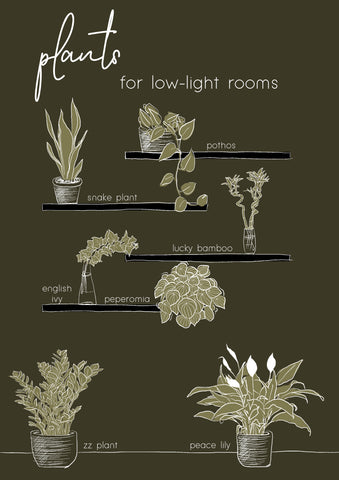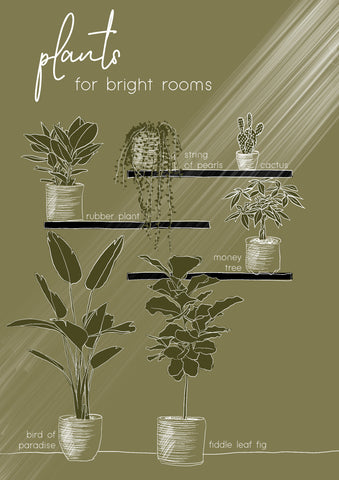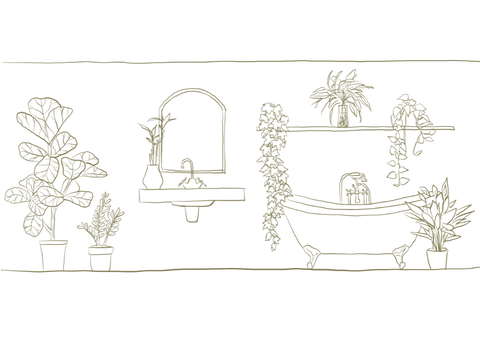Want to adorn your house with lush greenery, but have no idea where to start? The easiest approach is to consider one room at a time. Not only do certain plants do better in certain areas of the house, but strategically placing plants in your house can help facilitate some of our most vital needs, like a good night’s rest, for example.
Like humans, each plant has its own individual likes and dislikes. When these needs are met, our plants start to thrive and as thanks, they contribute to our mental and physical well-being in the most mysterious ways.
Factors to Consider When Selecting Plants
Being an avid collector of indoor plants and having referred to myself numerous times as a plant mom, a green thumb, an anthophile, and just about any other cringe plant noun you could think of, I have learned the hard way in which rooms to reside my indoor plants, and, more importantly, where not to place them.
- There are many factors that we need to consider when choosing indoor plants for a specific room:
- The amount of natural direct and indirect light that enters the room throughout the day.
- The use of the room (sleeping, eating, relaxing, working, washing up).
- The humidity level of the room.
- The temperature of the room.
- The aesthetic of the room (Does the scale of the plant work for the size of the space? Does the style and texture of the plant work for the design of the interior?).
Plants For Low Light Rooms
Just because you live in a poorly lit house, doesn’t mean you have to deprive yourself of the company of these beauties altogether. Sure, no plant necessarily prefers a poorly lit room, but there are many plants that are very content with these dungeon-like conditions. Among these are the ZZ Plant (Zamioculcas zamiifolia), Snake Plant (Dracaena trifasciata), Peace Lily (Spathiphyllum), and Pothos (Epipremnum aureum).
If you are set on having a specific plant in a low-lit room that needs very bright light to just barely survive, there are other solutions that are worth considering. One of these solutions is as simple as purchasing plant grow lights that imitate natural lighting.
There are also plenty of ways to lighten up a room visually, like painting the walls and ceilings white and sticking to noticeably light and natural colors for the furniture and decor. Light colors like white reflect light, which makes a space appear much bigger and encourages plant growth. Two for the price of one.

Plants for Bright Rooms
At the other end of the spectrum, there are also plants that enjoy bathing in very bright light throughout the day. Most indoor plants tend to fall into this category, so if you have a north-facing house with bright light streaming into the house through large windows, then you are in luck (and also, I envy you).
It is important to note that bright light doesn’t mean direct sunlight. Most plants have a severe dislike for direct sunlight, as it dehydrates them at a fast pace, and it can also cause the leaves to burn (just like us humans). Indirect sunlight can be achieved by diffusing north-facing windows by installing sheer fabric blinds or curtains, as well as applying sandblasting vinyl stickers to the interior of the windows.
Plants that enjoy bright light includes the String of Pearls (Senecio rowleyanus), Cacti, Rubber Plant (Ficus elastica), Money Tree (Ficus elastica), Bird of Paradise (Strelitzia), and the Fiddle-Leaf Fig (Ficus lyrate).

Plants for the Bedroom

The bedroom: The place where our bodies relax and recharge after busy days, in preparation for even busier days. The bedroom is one of the rooms in the house where we spend most of our time. Up to at least eight hours a day if you follow the doctor’s orders. The plants that you add to your bedroom as decor have the potential to contribute to your sleep quality, so it’s worth experimenting with these plants in your bedroom.
The Snake Plant is by far the best plant to have in your bedroom. Aside from being an exceptionally low-maintenance plant, the snake plant is one of the most air-purifying plants out there. What makes the snake plant such a terrific addition to the bedroom, specifically, is the fact that it releases oxygen during the day as well as at night, whereas most house plants only release oxygen during the day. Such a hard worker.
Other plants that will make great sleepover buddies are toxin-absorbing plants like English Ivy (Hedera helix), which is also known for clearing the air of mold and helping to alleviate allergy symptoms. Golden Pothos not only purifies the air, but it also absorbs unpleasant odors. Among the toxin-absorbing plants are Spider Plants (Chlorophytum comosum), Areca Palm (Dypsis lutescens), and the hardy Rubber Plant.
Plants for the Living Room

The other room in the house where we tend to spend a lot of our time is, of course, the living room. Not to be overlooked, as it is the room where we relax and entertain guests, and it is, in most homes, the focal point around which the entire house is designed.
When selecting plants for your living room, the most important aspect to consider is the available space. A lot of negative space calls for large plants, like the Bird of Paradise, especially if the said living room is filled with natural light throughout the day. Other large plants that are perfect as focal pieces include the infamous Fiddle Leaf Fig, Dragon Trees (Dracaena draco), and the Parlor Palm (Chamaedorea elegans).
Running out of space in your living room? Plants like the Prayer Plant (Chamaedorea elegans) and Polka Dot Begonia (Begonia maculata) are enjoyable conversation starters with their interesting leaf patterns, and they don’t take up a lot of space. Pothos can also be trained to fill those empty corners in your living room in the best conceivable way.
Plants for the Bathroom

The bathroom is THE best room in your house for your indoor plants. The reason for this is the humidity level in your bathroom. Think of your bathroom as a tropical oasis for your plants. Although most plants do quite well in bathrooms, there are some that like the humidity even more than others: Fiddle Leaf Fig, Lucky Bamboo (Begonia maculata), Chinese Evergreen (Aglaonema commutatum), ZZ Plant, English Ivy, Peace Lily, and Pothos are among the plants that make great bathroom buddies.
And no, contrary to popular belief, filling your bathroom with plants will NOT cause mold. On the contrary, plants prohibit the growth of mold by absorbing excess moisture from the air.
Plants for the Kitchen

This one is a no-brainer: Of course, plants like potted vegetables and herbs are a terrific addition to any kitchen. What is more inspiring than cooking in a kitchen filled with fresh produce? Aside from an actual chef being present, I can’t think of anything. Spring onions, mint, parsley, and basil are the ideal plants for a well-lit kitchen.
If, on the other hand, you don’t cook and your kitchen is strictly for decorative purposes (no judgment here), it is important to take into consideration the fact that the kitchen is the second most humid room in the house. Plants like air plants, Pothos, and String of Pearls will thrive in a humid kitchen.
Plants for the Home Office

The home office doesn’t have to be a dreadful and depressing room. Adding a few plants can inspire productivity and creativity, while instantly perking up the aesthetics of the room. Studies have shown that greenery in the workplace has a positive psychological effect on workers. This is why it is so important to try and bring the outside indoors as much as possible when it comes to the place where you live and, especially, where you work.
Depending on the quality of natural light in your home office, any plant that you find beautiful and inspiring should be placed on your desk! There are, however, plants like the Mum flower that absorb chemicals emitted from copiers and printers, which make them the ideal plants for your home office. Of course, if you are into feng shui, then the Money Tree is always a good option for your home office, as it encourages wealth and prosperity.
I hope this article inspired you to make a few home improvements by incorporating plants as an essential part of your home decor. If you’re still not sure where to start with your plant collection or addition, be sure to contact me and we will have your space greenified in no time.





